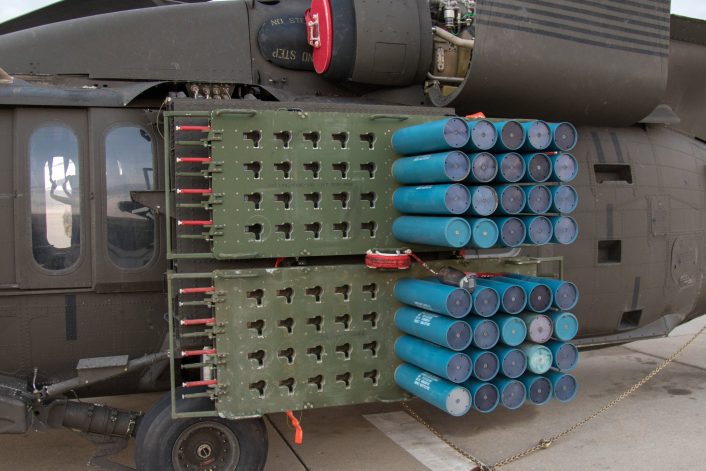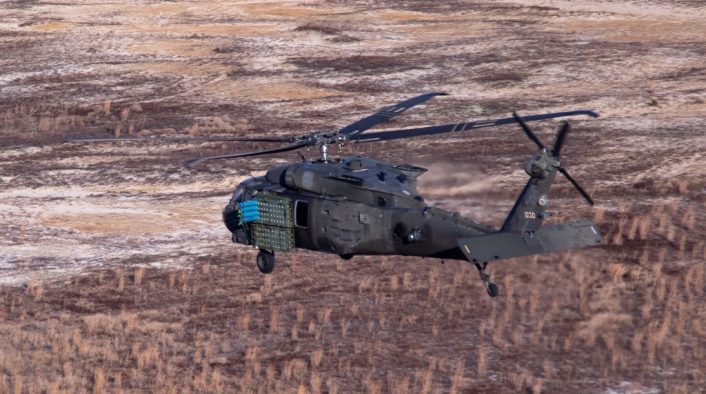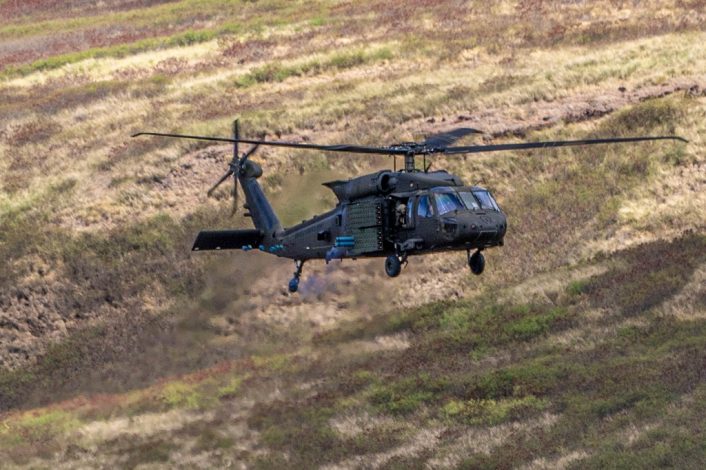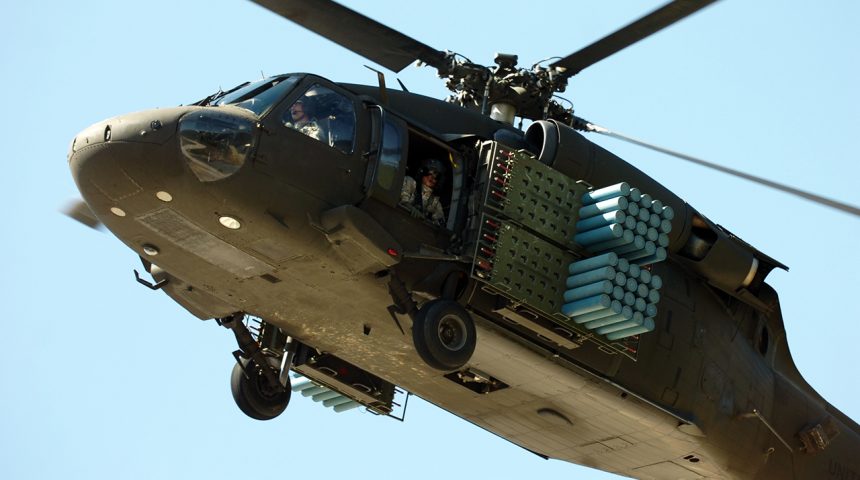The M-139 Volcano Mine Delivery System, originally built in the 1980s and ’90s, has been in storage for more than 20 years.
Recently, the 82nd Combat Aviation Brigade, part of the 82nd Airborne Division, posted some photos of the unit’s aircrews conducting qualifications on the M-139 Volcano Mine Delivery System mounted to the UH-60M Black Hawk on its social media accounts. The system is designed to rapidly scatter mines to create large minefields, meant to delay/disrupt enemy movement and protect the flanks of friendly units on the ground, by laying 960 mines in under one minute.
The M-139 Volcano was originally built in the 1980s and ’90s and it was stored for more than 20 years before the U.S. Army decided to resuscitate the system to provide a scatterable mine capability to the ground forces. The decision to restore this capability and begin to qualify again the crews is a consequence of the tactical strategies shift of the recent years, which foresaw a return to confrontations with near-peer adversaries and a definitive FLOT (Forward Line of Own Troops).
2-82 AHB conducted aircrew quals on the Volcano Mine System yesterday. Huge win to validate these systems are still FMC. This system is capable of laying 960 mines in under one minute! This can delay and disrupt enemy movement and protect our flanks. @82ndABNDiv @18airbornecorps pic.twitter.com/o7TpR5kwGR
— 82nd Combat Aviation Brigade (@82ndCAB) December 18, 2020
When work to refurbish the Volcano begun at the Anniston Army Depot, workers faced some challenges after many components were found corroded after being locked up for such a long time and many of them being out of production, requiring the “cannibalization” of some M-139 systems in order to salvage working components, at least until the development of a repair process is complete. Early works to test the viability of the re-introduction in service begun at the depot in 2014, with works on a larger scale funded in 2017.

The M-139 has two variants, the Ground Volcano, which can be mounted on trucks like the Heavy Expanded Mobility Tactical Truck (HEMTT), and the Air Volcano, that is now being adapted to the UH-60M Black Hawk. Before being stored, the system was qualified aboard the previous variant of the Black Hawk, the UH-60L. In 2017 the system was mounted for the first time on a UH-60M model Black Hawk at Fort Bliss (Texas), with the Army laying out a basic implementation plan and then working it out with the maintenance crews, before writing a technical manual for installations on the UH-60M later at other units.
The Combat Aviation Brigade of the 1st Armored Division then used the system during training at the National Training Center at Fort Irwin (California) while supporting 2nd Brigade Combat Team of the 1st Infantry Division. Other units that have been working on qualifying their aircrews are the 1st Combat Aviation Brigade of the 1st Infantry Division in 2018 and the 25th Combat Aviation Brigade of the 25th Infantry Division earlier this year.

The Volcano uses modified Gator mines, the same that were developed to be dropped by aircraft inside the CBU-78/B (Navy) and CBU-89/B (Air Force). The entire system is made of four main components, which are the mine canister, the dispenser, the dispenser control unit (DCU) and the mounting hardware. The latter includes a jettison subassembly to be fitted to the Black Hawk to detach and propel the racks and canisters away from the aircraft in the event of an emergency.

The M-139 uses M87 and M87A1 mine canisters which contain five Anti-Tank (AT) mines and one Anti-Personnel (AP) mine or six AT mines, respectively, plus a propulsion device to scatter them 35 to 70 meters away from the helicopter. The mine canisters are capable of dispensing mines with 4-hour, 48-hour, and 15-day self-destruct timers.
The U.S. Army is working to upgrade the system so that it can remain in service for at least 15-20 years, and a part of the works is meant to make the system fully compliant with the Ottawa Treaty, the Anti-Personnel Mine Ban Convention, even if the United States is a non-signatory state. The treaty covers only anti-personnel mines and does not address anti-tank mines, so it is safe to say that the Volcano will use only the M87A1 mine canisters or upgraded variants.
The M-139 can be used to emplace large minefields rapidly both offensively, to destroy, delay or deviate enemy forces, and defensively, to block potential avenues of approach from a flank and reduce friendly forces vulnerabilities to counterattack. The Air Volcano is considered the fastest method for accurately emplacing these large tactical minefields in deep, close, and rear operations, but the helicopter is extremely vulnerable while flying at the steady low altitude, low speed, and the regular path required to scatter the mines.
Some other limitations are performance-related, as the Black Hawk is near its maximum takeoff weight (MTOW) when the system is installed and it’s slower and handles differently, while some others are self-defense-related, as the crew cannot operate the M-240 machine guns that are usually pintle mounted on the helicopter. The latter, added to the extreme vulnerability of the UH-60M during the mine-laying process, require the coordination with AH-64 Apache attack helicopters to provide security.
While the use of the Volcano Mine Delivery System can be controversial because of the nature of the weapon and the Ottawa Treaty, it is worth noting that the U.S. forces ended the use of persistent landmines in 2010, while in 2014 the Obama administration changed the U.S. Anti-Personnel Landmine (APL) policy by banning the production and acquisition of APLs, restricting their use only to the Korean Peninsula to defend South Korea.
However, this year, the Trump administration published a new policy that basically reversed the 2014’s one. According to the Department of Defense, the 2020 policy “encourages the Military Departments to explore acquiring landmines that could further reduce the risk of unintended harm to non-combatants.”
In 2016 the U.S. Army set up a program “to develop an Ottawa Convention-compliant air-delivered, operator-controlled munition system that will provide both antivehicle and antipersonnel munitions and will replace the current GATOR system, with an initial operating capability goal by FY25”. The Gator Landmine Replacement Program was reportedly focused on AT mines only to initially supplement and then replace the Volcano and similar systems. It is not known if the recent change in policies will affect the Volcano and the Gator Landmine Replacement Program in any way.









